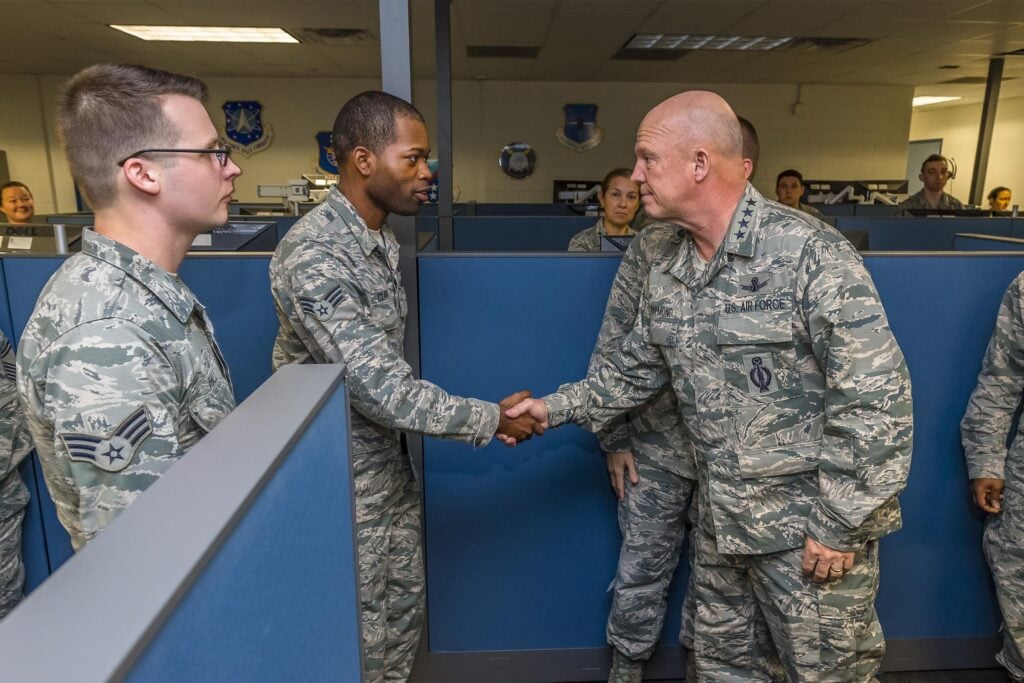 CAPITOL HILL: Air Force Space Command’s new system for command and control of battlefield space assets during conflict is “on the verge” of operational capability, says Gen. John Raymond.
CAPITOL HILL: Air Force Space Command’s new system for command and control of battlefield space assets during conflict is “on the verge” of operational capability, says Gen. John Raymond.
The Enterprise Space Management Command and Control (ESBMC2) system is one element of AFSPC’s year-old data strategy that is “already beginning to pay benefits,” said Raymond, who commands both AFSPC and the new Space Command. “A lot of the challenges we face in space are big data problems,” he said.
AFSPC now has “developed use cases to demonstrate the goodness” of ESBMC2, Raymond said Friday, “and we’re going to demonstrate it here again in front of Corona.” Coronas are regular meetings of Air Force leadership; the next one is planned for October. The second occurs in the spring.
Raymond said the use of open-source architectures is key to ESBMC2 because it is integrated as the space system element of Air Force Multi-Domain Command and Control (MDC2). ESBMC2 replaces the canceled Joint Mission System III. It is aimed at better integrating DoD’s space situational awareness (SSA) data and satellite C2 with National Reconnaissance Office (NRO) operations, within the National Space Defense Center (NSDC) at Schriever AFB in Colorado. In particular, NSDC will integrate the warnings and indications from NRO’s spy satellites and data from military space assets, so the National Command Authority can defend all US assets in space.
ESBMC2 also will reflect the Air Force’s “pivot” on SSA away from a focus on cataloging objects in space to “a warfighting focus,” Raymond told the Mitchell Institute gathering. As space has morphed from a “benign domain” to a “warfighting domain,” Raymond said, “we do not have the luxury of just being satisfied with knowing where an object is; you have to know more than that.”
The ESMC2 software development approach is serving as the model for the entire service’s software development, and is likely to be emulated across DoD, Col. Stephen Purdy, director of the Space Superiority Systems Directorate at the Space and Missile Systems Center (SMC), told reporters after Raymond’s presentation.
“We’re changing the way software is developed, and we’re following the Silicon Valley model,” Purdy said. Rather than developing one big software package at a time, the Air Force is creating a “development pipeline,” he said. “It’s all about breaking the pieces of software down into micro pieces,” with “strong connectivity in between each of the software mods” so upgrades can be fielded rapidly.
These upgrades come in “three month increments,” Purdy said, called “Program Increment Drops.” He explained that the software developers work with AFSPC to figure out the latest user priorities, that in turn drive what updates are put into motion. “We work those out, then we go off and do small development teams on a continuous pipeline development process. Then we drop those out into a test environment,” he explained.
“We’re not spending a bunch of time building a million lines of code and then trying to test it, and it affects 15 million lines of code,” Purdy added. “You achieve the small victories, and you get them out to the warfighter.”
He noted that the Air Force’s new Cloud One initiative, announced by acquisition czar William Roper at the 2019 Air Force Association conference earlier this month, is a foundation for ESBMC2 software development. Roper told Breaking D that Cloud One will merge all the Air Forces various software development ‘factories’ (such as the Boston-based Kessel Run) into a single cloud-based environment. Roper said his dream is to have a future Air Force fighter take off with one software version and land with another — something he said is not at all “far fetched” as the service hones its code-writing chops.
The Cloud One effort, being managed by defense consulting behemoth SAIC, is enabled in large part by the use of a special type of open-source software for app development called Kubernetes. Kubernetes allows the app to be developed together with the operating environment it needs, and a platform to allow it to be updated rapidly as user requirements change.
Purdy explained that the ESBMC2 effort is also affected by SMC’s reorganization, known as SMC 2.0. It now is the responsibility of SMC’s Cross Mission Ground unit, which is charged with merging the Air Force’s Enterprise Ground System (EGS) unified C2 architecture and the Future Operationally Resilient Ground Evolution (FORGE) ground system for the Space Based Infrared System (SBIRS) missile-warning satellite constellation.
Back in April, Raymond told the House Armed Services Committee’s Strategic Forces Subcommittee that “early ESBMC2 prototypes have demonstrated initial interoperability with Air Combat Command (ACC), the Intelligence Community, and the Missile Defense Agency to synchronize operations.”
In a ‘world first,’ DARPA project demonstrates AI dogfighting in real jet
“The potential for machine learning in aviation, whether military or civil, is enormous,” said Air Force Col. James Valpiani. “And these fundamental questions of how do we do it, how do we do it safely, how do we train them, are the questions that we are trying to get after.”


























